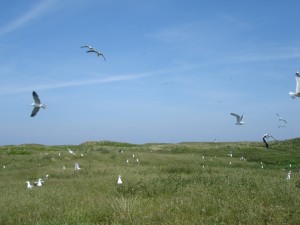Having explored the interactions between Lesser Black-backed Gulls and wind farms at a colony on the east coast of Britain, we expanded this project to include two colonies on the west coast of Britain, Skokholm Island in southwest Wales and South Walney (part of Walney Island) in northwest England.
South Walney (54° 05′N, 3° 19′W) is part of the Morecambe Bay and Duddon Estuary proposed Special Protection Area (pSPA). The Lesser Black-backed Gull population here has fallen from more than 40,000 pairs in 1978 to less than 4,000 pairs in 2014. It is therefore important to establish how this population uses the marine environment and how it might be affected by offshore wind farm developments, both during the breeding season and at other times of the year.

25 UvA-BiTS tags were fitted to adult Lesser Black-backed Gulls in 2014 and interactions with wind farms have been assessed both in the breeding season and through migration and wintering periods.
The work at South Walney has been extended, with 20 further tags fitted to adult Lesser Black-backed Gulls in 2016, to investigate the movements of gulls in relation to construction of the Walney Extension and Burbo Bank Extension offshore wind farms. Through this work, and also using information from birds tagged in previous years, we will assess changes in the area use and behaviour of birds through the construction of the wind farms and into their operation.
Data from the study are also contributing to a PhD investigating differences in the ecology of Lesser Black-backed Gulls from protected site and urban colonies.
Contact persons, funders and participants
Chris Thaxter, British Trust for Ornithology chris.thaxter@bto.org
Niall Burton, British Trust for Ornithology niall.burton@bto.org
Viola Ross-Smith, British Trust for Ornithology viola.ross-smith@bto.org
Willem Bouten, University of Amsterdam Institute for Biodiversity and Ecosystem Dynamics / Instituut voor Biodiversiteit en Ecosysteem Dynamica (IBED) w.bouten@uva.nl
Sponsored by the Department for Business, Energy & Industrial Strategy
Supported by:
- Skokholm Bird Observatory
- Natur Wildlife Trust South and West Wales

